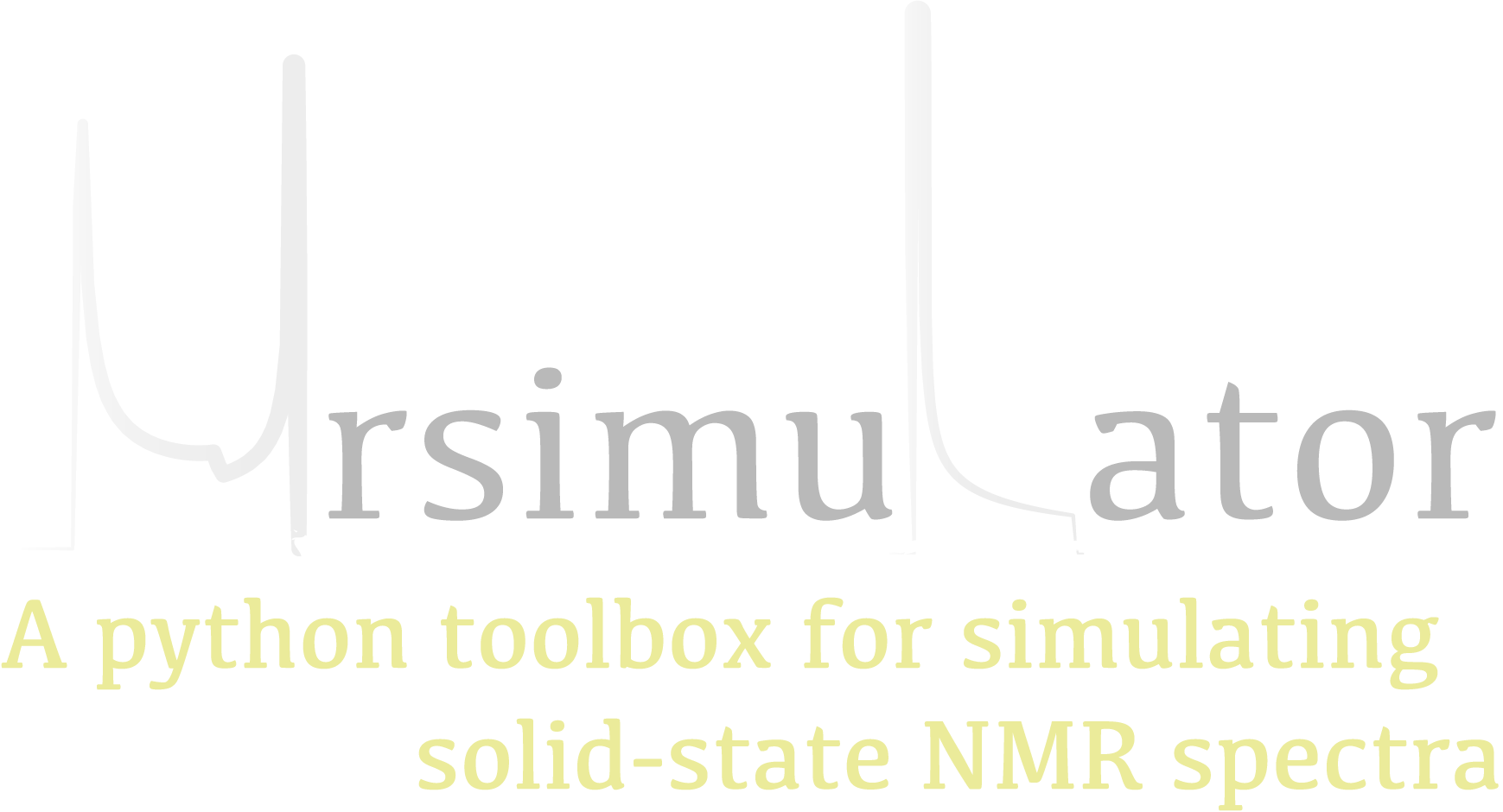Site¶
-
class
mrsimulator.Site(*, property_units: Dict = {'isotropic_chemical_shift': 'ppm'}, name: str = None, label: str = None, description: str = None, isotope: str = '1H', isotropic_chemical_shift: float = 0, shielding_symmetric: mrsimulator.spin_system.tensors.SymmetricTensor = None, shielding_antisymmetric: mrsimulator.spin_system.tensors.AntisymmetricTensor = None, quadrupolar: mrsimulator.spin_system.tensors.SymmetricTensor = None)¶ Bases:
mrsimulator.utils.parseable.ParseableBase class representing a single-site nuclear spin interaction tensor parameters. The single-site nuclear spin interaction tensors include the nuclear shielding and the electric quadrupolar tensor.
Attribute Documentation
-
isotope¶ A string expressed as an atomic number followed by an isotope symbol, eg., ‘13C’, ‘17O’. The default value is ‘1H’.
Example
>>> site = Site(isotope='2H')
- Type
str (optional)
-
isotropic_chemical_shift¶ The value is the isotropic chemical shift of the site in the unit of ppm. The default value is 0.
Example
>>> site.isotropic_chemical_shift = 43.3
- Type
float (optional)
-
shielding_symmetric¶ The value of this attribute represents the irreducible second-rank traceless symmetric part of the nuclear shielding tensor. The default value is None.
The allowed attributes of the SymmetricTensor class for shielding_symmetric are
zeta,eta,alpha,beta, andgamma, wherezetais the shielding anisotropy, in ppm, andetais the shielding asymmetry parameter defined using the Haeberlen convention. The Euler anglesalpha,beta, andgammaare in radians.Example
>>> site.shielding_symmetric = {'zeta': 10, 'eta': 0.5} >>> # or equivalently >>> site.shielding_symmetric = SymmetricTensor(zeta=10, eta=0.5)
- Type
SymmetricTensor or equivalent dict object (optional).
-
shielding_antisymmetric¶ The value of this attribute represents the irreducible first-rank antisymmetric part of the nuclear shielding tensor. The default value is None.
The allowed attributes of the AntisymmetricTensor class for shielding_antisymmetric are
zeta,alpha, andbeta, wherezetais the anisotropy parameter of the anti-symmetric first-rank tensor given in ppm. The anglesalphaandbetaare in radians.Example
>>> site.shielding_antisymmetric = {'zeta': 20} >>> # or equivalently >>> site.shielding_antisymmetric = AntisymmetricTensor(zeta=20)
- Type
AntisymmetricTensor or equivalent dict object (optional).
-
quadrupolar¶ The value of this attribute represents the irreducible second-rank traceless symmetric part of the electric-field gradient tensor. The default value is None.
The allowed attributes of the SymmetricTensor class for quadrupolar are
Cq,eta,alpha,beta, andgamma, whereCqis the quadrupolar coupling constant, in Hz, andetais the quadrupolar asymmetry parameter. The Euler anglesalpha,beta, andgammaare in radians.Example
>>> site.quadrupolar = {'Cq': 3.2e6, 'eta': 0.52} >>> # or equivalently >>> site.quadrupolar = SymmetricTensor(Cq=3.2e6, eta=0.52)
- Type
SymmetricTensor or equivalent dict object (optional).
-
name¶ The value is the name or id of the site. The default value is None.
Example
>>> site.name = '2H-0' >>> site.name '2H-0'
- Type
str (optional)
-
label¶ The value is a label for the site. The default value is None.
Example
>>> site.label = 'Quad site' >>> site.label 'Quad site'
- Type
str (optional)
-
description¶ The value is a description of the site. The default value is None.
Example
>>> site.description = 'An example Quadrupolar site.' >>> site.description 'An example Quadrupolar site.'
- Type
str (optional)
Example
The following are a few examples of setting the site object.
>>> site1 = Site( ... isotope='33S', ... isotropic_chemical_shift=20, # in ppm ... shielding_symmetric={ ... "zeta": 10, # in ppm ... "eta": 0.5 ... }, ... quadrupolar={ ... "Cq": 5.1e6, # in Hz ... "eta": 0.5 ... } ... )
Using SymmetricTensor objects.
>>> site1 = Site( ... isotope='13C', ... isotropic_chemical_shift=20, # in ppm ... shielding_symmetric=SymmetricTensor(zeta=10, eta=0.5), ... )
Method Documentation
-
classmethod
parse_dict_with_units(py_dict)¶ Parse the physical quantity from a dictionary representation of the Site object, where the physical quantity is expressed as a string with a number and a unit.
- Parameters
py_dict (dict) – A required python dict object.
- Returns
Site object.
Example
>>> site_dict = { ... "isotope": "13C", ... "isotropic_chemical_shift": "20 ppm", ... "shielding_symmetric": {"zeta": "10 ppm", "eta":0.5} ... } >>> site1 = Site.parse_dict_with_units(site_dict)
-
to_freq_dict(B0)¶ Serialize the Site object to a JSON compliant python dictionary object, where the attribute value is a number expressed in the attribute’s default unit. The default unit for the attributes with respective dimensionalities is:
frequency:
Hzangle:
rad
- Parameters
B0 (float) – A required macroscopic magnetic flux density in units of T.
- Returns
Python dict object.
Example
>>> pprint(site1.to_freq_dict(B0=9.4)) {'description': None, 'isotope': '13C', 'isotropic_chemical_shift': -2013.1791999999998, 'label': None, 'name': None, 'quadrupolar': None, 'shielding_antisymmetric': None, 'shielding_symmetric': {'alpha': None, 'beta': None, 'eta': 0.5, 'gamma': None, 'zeta': -1006.5895999999999}}
-
json() → dict¶ Parse the class object to a JSON compliant python dictionary object where the attribute value with physical quantity is expressed as a string with a number and a unit.
>>> pprint(site1.json()) {'isotope': '13C', 'isotropic_chemical_shift': '20.0 ppm', 'shielding_symmetric': {'eta': 0.5, 'zeta': '10.0 ppm'}}
-
